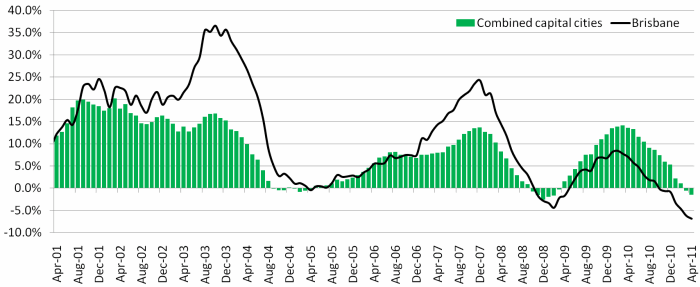My long time readers would know that I was certainly not supportive of the first home buyers grant boost that the government implemented as part of its stimulus packages in response to the GFC. I have previously mentioned my issues with this sort of policy.
- It is unsustainable
- It brings forward demand, [so] can therefore artificially push up prices
- Once the stimulus demand is gone the demand “falls of a cliff” and prices fall
- People who took on debt to buy and item during the stimulus period can find themselves with more debt that the item is worth, and have trouble offloading the item because there are not many people left who want the item who don’t already have one.
I have previously described the effects of the first home buyers grant boost as a “stimulus driven demand bubble” and you can see the results on the housing market’s churn rate from the Unconventional Economist’s latest post. But as I warned above, once the stimulus ends the churn rate collapses and down come the prices. This obviously leave some unfortunates who took the bait at the height of the price boom in a very difficult position.
The cheapest part of Labor’s 2008-09 stimulus package has come back to bite the economy, with a hole left in the housing market after a record number of first-home buyers brought forward their purchases and forced up prices during the global financial crisis.
Demand from first-time buyers is now at its lowest level in seven years, but the slack has not been picked up by repeat buyers. This breaks the pattern of the previous government-induced first-home buyer boom in 2001, when repeat buyers filled the void at the other end of the stimulus cycle. Labor trebled the first-home owner grant for new homes, and doubled it for existing dwellings as part of the first stimulus package announced in October 2008, at a cost of $1 billion.
The immediate effect of the handout was to encourage people to borrow more. The average size of a loan taken out by a first-home buyer increased by 25 per cent in the year to March 2009, and house prices followed, with the median price jumping 15.5 per cent in the year to the March quarter last year.
This repeated the affordability sting of the previous doubling of the first-home owner grant by the Howard government in March 2001. The average loan size increased by 26 per cent in the year to October 2001, and the median house price rose by 21 per cent in the year to the September quarter 2001.
Labor used the grant to prevent a freefall in house prices during the GFC. Sources at the time said it was a confidence play, aimed at placing a floor under the market. As with much of the stimulus, it worked better than expected, and left Australia with the mixed blessing of another house price surge.
Officials had long understood the first-home owner grant fed straight into prices when it was increased on a temporary basis. But they didn’t anticipate that prices would rise faster during the GFC than they did during the first phase of the mining boom between 2004 and 2007.
Now that the market is flat, and prices are falling, the most recent entrants to mortgageville may feel a little ripped off.
If you take a look at the Brisbane market you can certainly see the possibility that someone who purchased in the last 12 months probably won’t be too chuffed with their timing. The same goes for some of the other Australian capitals, such as Perth and Adelaide as well as other regional areas.
However, I don’t think the market is quite at the stage where anyone who purchased in 2009 would be feeling ripped off. In fact I am sure there are plenty of people that have been able to sell-out, or release equity in the last 12 months that would be feeling quite happy with their purchases during the stimulus boom. But in my opinion the market has further to fall, and in Queensland and WA there certainly is already the potential for First Home Buyers Grant Boost recipients to be holding mortgages near or above the value of their houses. If the market falls further the number of these people will obviously rise.
The other side of this story (not mentioned in the article) is the systemic risk created by debt stimulating policy. The RBA’s financial stability report shows that at the height of stimulus period the Australian banks were issuing 1 in 4 loans to owner occupiers with an LVR above 90%, I assume that many of these were issued using the FHG as the major component of their deposit . As I have mentioned recently the only real reason these people would now be holding lower LVR loans is because of rising prices, created by that same stimulus policy. If the market continues to fall as the effects of that stimulus wear off there is the potential that the Australian banks will be holding large numbers of risky loans on their books at a time when the market is falling.
Obviously the RBA is watching on as it tries to balance the economy between the housing market and Futureboom! dynamics. But I am sure that is little comfort to those already concerned about their financial position when the housing market is falling and the costs of living are increasing. If a continuation of the downward trend in prices suddenly leads to a stampede to the exits then my question about responsibility will no longer be hypothetical.
